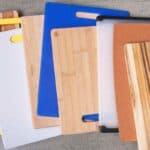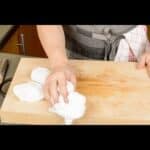Wood Cutting Board
Is cleaning wood cutting board necessary? Cutting boards made of wood…
…are an excellent kitchen tool and accessory. Cutting boards are one item that you can never have too many of in your kitchen. Cutting boards are essential not just for keeping your countertop clean, but also for correctly cooking meat, poultry, vegetables, and other foods. A good cutting board is also critical for food safety.
But which cutting board is the best? The safety of wood cutting boards vs plastic cutting boards has been disputed for years, but a research found that, contrary to common perception, wood cutting boards are actually safer than plastic. This isn’t to say you should get rid of all of your plastic cutting boards, and if you don’t know how to properly clean your cutting board, it doesn’t matter what sort you use.
How To Do Cleaning Wood Cutting Board
While the dishwasher is ideal for cleaning and sanitizing most things in your kitchen, some items simply cannot be cleaned effectively inside a machine. For example, wooden surfaces like cutting boards often become stained or discolored when they come into contact with certain types of food such as tomatoes, onions, citrus fruits, meats, etc.
These stains cannot always be removed from these materials by washing them within the dishwasher because the heat will damage delicate fibers of the material. In addition, even though dishwashers may remove surface dirt, there’s no guarantee that hidden bacteria won’t remain on the surface after being washed. As such, proper hand-washing techniques must be used whenever possible.
If you want to keep your cutting board safe from germs while still maintaining its appearance, then using soap might not be enough. To ensure better results, follow this guide:
- Wipe down the cutting board immediately following each meal. If you wait until later to wipe off any residue left behind, you could end up spreading harmful microbes around your home. Make sure to wash everything thoroughly first before wiping down the board so that nothing gets lost during the process. Also make sure to rinse off the knife right away as well since knives tend to harbor more dangerous microorganisms than cutting boards do.
- Use warm water instead of cold when rinsing out your cutting board. Cold water tends to dry out the cutting board faster causing it to crack over time. Warm water helps prevent cracking and keeps the entire board looking fresh longer.
- Don’t leave wet towels lying around near your cutting board. Instead, hang damp cloths next to where your cutting board sits. They’ll help absorb excess moisture and thus reduce the risk of mold growth.
- Avoid leaving hot pans or dishes directly above your cutting board. Heat from the pan can cause the wood to expand resulting in cracks. Try placing the pan below the cutting board rather than having it sit directly on top.
- Never place your cutting board upside down! While drying out the board overnight seems harmless enough, doing so can result in warping and breaking. It’s important to remember that the underside of the board is usually covered in dried spills and sauces making it much harder to clean. When storing your cutting board, try stacking it vertically against another similar sized board to avoid damaging either piece.
- Keep your cutting board stored at room temperature. Storing your cutting board in a cool environment allows condensation build up on the bottom side of the board. If allowed to continue unchecked, this buildup can eventually lead to bacterial growth and rotting. Store your cutting board in a location where air circulation is constant. You can easily achieve this by hanging it on the wall or door frame outside of your refrigerator.
- Always store your cutting board far from direct sunlight. The sun emits ultraviolet rays that will destroy the natural oils present in the wood. Ultraviolet exposure causes the wood to lose color and strength.
How to Maintain Your Wood Cutting Board
To avoid cracking, dryness, and warping of the wood cutting board, it’s best to oil the board once a month. This prevents excessive expansion caused by heating and also adds protection against insects. Before applying an oil solution, however, check if the board has been exposed to extreme temperatures. Exposing the board to heat and/or steam will weaken the protective layer covering the board which makes it susceptible to cracking.
Once a month, apply vegetable shortening all along the edges of the board. Applying the shortening evenly ensures that the board remains flat and stable throughout the year. Avoid putting too much shortening onto the board; just enough should cover the sides completely without dripping anywhere else. Once applied, let the board rest for about 10 minutes before proceeding with other maintenance tasks.
It’s recommended that you use mineral spirits or denatured alcohol to clean your cutting board regularly. Mineral spirits are effective cleaners but require extra effort to get rid of the solvent smell. Denatured alcohol is odorless and leaves no trace behind.
Use only pure denatured alcohol products in order to protect yourself from inhaling any potentially hazardous chemicals. Apply the cleaner to both sides of the board and allow it to soak through to the base. Let the board stand undisturbed for 15 minutes before wiping off the remaining liquid. Finally, carefully brush off any dust particles stuck between the grains of the wood.
Our Latest Post:
💻Deep Fryer |Spice Grinders and Coffee Grinders | Mini Portable Refrigerators
Was this helpful?
Hi there! I’m a food enthusiast and journalist, and I have a real passion for food that goes beyond the kitchen. I love my dream job and I’m lucky enough to be able to share my knowledge with readers of several large media outlets. My specialty is writing engaging food-related content, and I take pride in being able to connect with my audience. I’m known for my creativity in the kitchen, and I’m confident that I can be the perfect guide for anyone looking to take their culinary journey to the next level.









